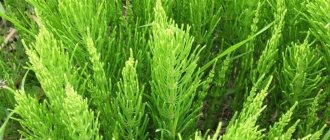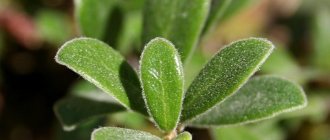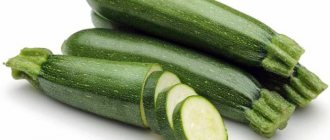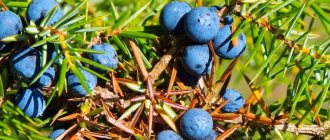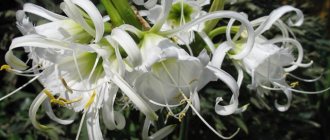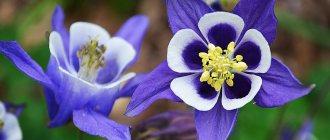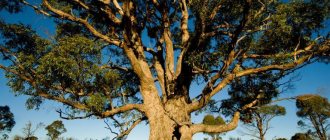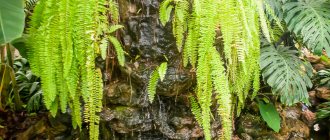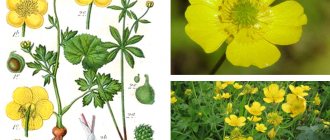About hacienda » Flowers and plants
Flowers and plants
The ancient forests where dinosaurs once roamed were teeming with giant horsetails that reached the height of large trees today. Today, 350 million years later, horsetails are mostly small herbaceous plants. In ancient times, horsetail stems rich in silica were used to clean pots and pans.
Horsetail (Photo used under standard license ©ofazende.ru) 448 Thin, hollow, jointed stems of horsetails are usually studded with rings of green branching twigs and tiny dark scales - leaves. Horsetails have a deep, well-developed root system and grow using rhizomes. In summer, cones appear at the end of the stems, in which spores form. In livestock that eat horsetail for a long time, serious poisoning occurs - equisetosis ("drunken illness").
Before using horsetail preparations, consult your doctor. They should not be used during pregnancy or breastfeeding.
Related article:
Schisandra plant: photos, types, cultivation, planting and care
Varieties
Horsetail (E. agvense)
The variety reaches a height of 80 cm, and its stems are studded with whorls of thin horizontal branches.
Horsetail (Photo used under standard license ©ofazende.ru)
Wintering horsetail (E. hyemale)
The variety sometimes grows waist-high; there are no branches on its stems.
Horsetail overwintering
Description
As soon as the spring sun shines, horsetail begins to sprout in the gardens, which is classified by our summer residents as a weed.
Horsetail likes to grow in acidic soil, this is a signal to start alkalizing the soil
The plant, which belongs to the higher spore species, has a height of 10 to 40 cm, its stems end in a spore-bearing pistil in the form of a spikelet, in which seeds - spores - are located. As soon as they are scattered, the stem dies and leaf development begins. They have a tetrahedral shape, a bright green tint, and branch well on the lower parts of the plant. Horsetail branches are directed upward, towards the sun.
The root system of the plant culture goes deep into the ground, almost a meter, this makes it easy to find food and water. Nodules in the form of balls are located on the roots, and substances that provide nutrition to the above-ground part accumulate in them.
This amazingly hardy crop can tolerate both low and high temperatures, light frosts and unbearable heat; it adapts to drought and thrives in rainy summers.
Horsetail likes to grow in sandy, acidic soil. If it once settled in your garden, we can assume that you have problems: firstly, it’s time to alkalize the soil and add ash or slaked lime, and secondly, a harmful weed has settled on your site, which will be quite problematic to get rid of.
There are several types of horsetail, but only one of them can be eaten and used as a medicine. Only a plant with branches pointing upward is healing. It is better not to touch the rest, otherwise the treatment may turn into an exacerbation of the disease. There have been cases when horses in villages died after eating the “wrong” horsetail contained in hay.
People call the plant by different names: field pine, nursery grass, honeydew, water pine, horsetail, morel, Sokhatin grass.
It is difficult to imagine that once upon a time, at the dawn of centuries, these plants looked like giant trees, which occupied a vast territory on Earth with powerful horsetail forests. It is thanks to them and giant ferns that today we have such a mineral as coal. Today we see only short and rather puny green bristles, which complement the fragrant meadow herbs.
The most dangerous is the marsh horsetail, which grows in swamps. It can be distinguished by its thick stem and few branches. Horsetail must not be confused with meadow horsetail; this can have a very negative impact on health.
Meadow and swamp horsetail contain poison, which causes the death of domestic and wild animals
Botanical description
Horsetail reaches a height of 40-50 cm. It has a long creeping rhizome on which tuberous branches are formed. There are two types of horsetail shoots:
- generative: pinkish or brownish, with triangular leaf teeth of brown color. After the spores mature, the chlorophyll-free shoots die off or form lateral branches, become green and indistinguishable from vegetative shoots;
- vegetative: erect or erect hollow green shoots with an arrow-shaped tip.
From six to sixteen leaf teeth form whorls in which simple or weakly branched branches are directed obliquely upward. The leaves on the stem are reduced, vaginal, and cylindrical in shape. Almost cylindrical spikelets reach a length of 2-3 cm.
Chemical composition
Horsetail contains many substances that are used in the pharmaceutical industry. Among them are:
- alkaloids;
- saponin equisetonin;
- flavonoids;
- aconitic, oxalic and malic acids;
- fatty and essential oil;
- silicic acid salts;
- tannins, resins;
- vitamins;
- carotene and others.
Application of horsetail
Many old grandmothers can still tell how horsetail was used. Primarily for domestic purposes. It was used to dye wool and even polish metals. The broth perfectly cleaned kitchen utensils and also washed floors. This is because this plant contains a significant amount of silicic acid. Actually, it is the acid that makes it useful for medicinal purposes. Useful properties Any doctor will tell you that silicic acid is a very important component of the human body. A sufficient amount of it guarantees the excellent condition of connective tissue, skin, hair, and nails. Today, horsetail saves from many diseases; its use in inflammatory processes allows you to quickly cope with the disease. It is no less successfully used to stop bleeding, as an antiseptic or for disinfection. In addition, horsetail decoction works as a diuretic.
Useful properties of horsetail
Horsetail has been known for its healing properties since the time of Avicenna, the famous physician of antiquity, who mentioned it in his medical works as a remedy that effectively stops blood and cleanses the body of toxins and harmful substances.
In the 40s of the last century, the study of horsetail began in medical institutions around the world, after which the medical community proved the unconditional benefits of horsetail for human health.
In scientific works, horsetail looked like a panacea for many diseases of various types.
In fact, it is a strong antioxidant, antiexudative, diuretic and antifungal agent, and has an antispasmodic effect. The importance of the plant in the pharmaceutical industry can hardly be overestimated, since today many drugs are being created that are based on substances from its composition.
Common horsetail has become a real breakthrough in pharmacology and traditional medicine
Types of horsetail
Horsetail has more than 20 species:
Riverside horsetail (Equisetum fluviatile)
Perennial, grows along the banks of stagnant bodies of water. The stems are not branched or weakly branched, soft, hollow, ribbed. Leaf whorls are cylindrical. The main axis and lateral branches end in a spikelet. Contains small amounts of nicotine, palustrin and aconitic acid.
Horsetail (Equisetum palustre)
Habitat: swamps, meadows, swampy forests. Angular-furrowed stems reach 40 cm. The branches are unequal, arched inward. Contains palustrin, nicotine, equisetonin, flavonoids, silica (10%).
Horsetail (Equisetum pratense)
Sporiferous and vegetative shoots develop simultaneously. After sporulation, the stem does not die, but turns green and develops lateral branches. The branches are simple, horizontal or drooping, up to 8 cm long. There are no branches in the lower part of the stem.
Horsetail (Equisetum sylvaticum)
The height of the perennial is 25-60 cm. Habitat is clearings, forests, often coniferous. The sheaths are bell-shaped, with reddish teeth. The complex structure of horsetail branches gives the plant an “openwork” appearance.
Wintering horsetail (Equisetum hyemale)
Shallow, coastal, evergreen crop. Forms bunches of hard, thick shoots with a sharp spikelet.
An interesting property of horsetail is the absorption of minerals contained in the soil, including gold, by concentrating them in its tissues.
Healing effect
Doctors use preparations containing horsetail to treat urolithiasis and kidney disease. The power of its effect surpasses even kidney tea. But it should be remembered that medications based on it cannot be used for nephritis, since some substances are irritants to the kidneys.
When diagnosing diseases such as heart and pulmonary failure, edema, horsetail helps to effectively expel excess fluid from the body and thereby alleviate the patient’s condition.
Other properties:
- it has astringent property;
- stops inflammatory processes;
- removes lead and other heavy metals from the body;
- it significantly reduces blood sugar levels;
- in small doses it has a positive effect on the reproduction of collagen and bone tissue;
It is not recommended to use horsetail in large doses.
Features of the use of horsetail for women, men and children
The beneficial properties of horsetail are used in the treatment of purely male or female diseases. Horsetail is a very valuable plant for women.
- The hemostatic activity of horsetail components is effective for the treatment of heavy and painful periods.
- Silica is needed for the formation of collagen, which forms the basis of the connective tissue of the body and ensures its strength and elasticity. Cosmetologists recommend using horsetail on the face.
- A cup of horsetail tea is a good prevention of osteoporosis, which often affects women during menopause.
Horsetail is useful for men as a possible treatment for benign enlarged prostate gland. It relieves swelling and cleanses the prostate.
Children may take horsetail preparations for bedwetting or diarrhea.
Horsetail for adenoids, judging by the reviews, shows good results. For treatment, you need to instill an aqueous infusion of the herb into the child’s nose - 5 drops in each nostril three times a day. As improvement occurs, the dosage can be reduced to twice, then once a day.
Sebastian Kneipp (German healer, priest, 19th century) recommends that everyone over 40 years old drink a cup of horsetail tea every day. Tea maintains the elasticity of blood vessels and strengthens memory.
Recipes for various diseases
Adenoids
For this disease, a medicinal collection of horsetail should be used. The recipe is as follows: pour 2 tablespoons of the mixture into a glass of water and boil for several minutes. Cool the product and rinse the nasopharynx with it. Repeat the procedure twice a day for a week.
Atherosclerosis
A healing mix consisting of several medicinal plants will help here. You need to take one part each of horsetail herb, birch leaf, dandelion root, wheatgrass root, soapwort root, yarrow herb, chokeberry fruit, and corn silk. Mix the ingredients and pour a glass of boiling water, leave for half an hour, strain and drink 100 ml three times a day after meals.
Vascular atherosclerosis
Arthritis
Pour a large spoonful of horsetail herb into a glass of hot water, wait half an hour and drink the infusion one glass a day.
Bronchiectasis
To treat pulmonary diseases, you will need a medicinal mixture, to which equal amounts of oregano herb, St. John's wort, and cinquefoil rhizome are added. To all of the above you should add knotweed and horsetail grass, but three times more than the rest of the grass. Pour two large spoons of herbal mixture into 400 ml of hot water and leave in a thermos for at least 20 minutes. Take the medicine half a glass a day.
Bronchiectasis
Glomerulonephritis
To collect you need to prepare:
- 4 parts each of St. John's wort and bearberry leaf;
- 3 parts each of horsetail herb, birch buds;
- 2 parts each of knotweed, corn silk, oregano, chamomile flowers.
Take four large spoons of the mixture and pour a liter of not hot water, let it brew for 12 hours, then boil for 5 minutes. Strain and take 200 ml on an empty stomach, gradually drink the rest throughout the day.
Haemorrhoids
For hemorrhoids, you can drink, make a poultice, and add a medicinal herbal mixture to the bath while bathing, consisting of three parts of oak bark, two parts of horsetail, one part of steelhead root, chamomile flowers and tansy. Pour half a liter of boiling water over 60 g of the mixture and leave for at least 4 hours. Drink 50 ml three times a day half an hour before meals.
For bleeding, take 1 part of buckthorn bark, flax seed, chamomile, dried grass, horsetail, and knotweed. A tablespoon of the mixture is mixed with a glass of boiling water and kept covered for 20 minutes.
Drink 1/3 three times throughout the day.
Purulent wounds
Tea for lotions is made as follows: brew a handful of horsetail herb with 200 ml of boiling water, boil over low heat for 5 minutes and do the procedures in the form of lotions.
Cholelithiasis
The collection consists of two spoons of dry horsetail root, which must be poured with two glasses of hot water. Drink the mixture in small sips four times.
Urolithiasis disease
One of the most popular preparations during urolithiasis helps relieve pain and helps remove stones from the body. It is done like this:
1 part horsetail, lingonberry leaf, strawberry leaf, caraway fruit, juniper fruit, licorice root. The collection is infused in hot water for half an hour, then filtered through cheesecloth and taken half a glass four times a day.
Nephritis
An infusion of two spoons of horsetail and a glass of boiling water is prepared in a water bath for about 30 minutes, infused for about 15 minutes, then filtered and drunk once every two days, 100 ml.
Pyelonephritis
Herbs such as horsetail, St. John's wort, violet grass, and motherwort are added to the collection in equal parts. Pour all ingredients into 200 ml of water and cook until tender for 25 minutes, drink in small portions throughout the day.
Psoriasis
Here you will need: celandine - 1 tsp, horsetail - 2 tsp, St. John's wort - 3 tsp, string - 3 tsp, black elderberry - 2 tsp, corn silk - 2 tsp, lingonberry - 2 tsp, calamus root - 3 tsp, elecampane root – 2 tsp.
Take the mixture in the amount of one tablespoon and pour hot water into a thermos in the evening. You can take the medicinal drink in the morning. Dose for psoriasis: 100 ml in the morning and before bed.
Seborrheic dermatitis
Washing the skin with dermatitis is carried out using a special medicinal infusion. It is prepared from a handful of dry grass and two glasses of boiling water. After the herb has infused, the liquid is filtered and procedures are performed.
Prostration
Horsetail tea is drunk several times throughout the day before meals; this remedy cleanses the body well.
Puffiness of the eyelids and eye fatigue
To relieve puffiness in the eyes and face, you can use the tea described above.
Acne
Horsetail and linden flowers must be taken in equal parts and mixed with boiling water. For procedures, use tampons soaked in liquid.
Cystitis
Several preparations are suitable for the treatment of cystitis.
- 1 recipe - during an exacerbation, tea made from dry herbs infused in boiling water will help.
- Recipe 2 – recommended for use in chronic forms of the disease. Here you can use both infusion and compresses. After the herb has been brewed and infused, it is placed in a bag made of canvas or linen and applied to the lower abdomen until the compress has cooled. At the same time, you need to drink a glass of infusion. After such treatment, the pain subsides and the disease gradually goes away.
- Recipe 3 - used for high levels of alkali in the urine and inflammatory processes in the bladder. You need to prepare a mixture of various herbs, taking them in equal parts. We take the leaves of horsetail, birch, bearberry, plantain, the roots of marshmallow, femur, licorice, and juniper fruits. After mixing all the ingredients, take a spoonful of the mixture and fill it with hot water. After prolonged infusion, strain and drink several times a day. Dose at a time – 1/3 cup.
Eczema
For eczema, we prepare an infusion of horsetail, string, rose hips, calendula, oak bark, and blackberry leaves.
It is better to prepare the medicine in a water bath for 10 minutes, then leave it until it cools completely and begin treatment with lotions or wrapping the inflamed areas of the skin.
What diseases does horsetail help with and what does it treat?
Due to the rich chemical composition of field grass:
- cleanses the blood and strengthens the walls of blood vessels;
- improves the functioning of the cardiac system;
- stops bleeding;
- helps fight inflammation and bacterial infections;
- promotes rapid healing of wounds and burns;
- removes parasites from the intestines;
- has diuretic properties and eliminates swelling;
- strengthens the immune system.
Indications for the use of horsetail include nervous disorders and poor concentration. Plant-based products are beneficial for diarrhea and gastrointestinal inflammation, cough and bronchitis, and irritation of the oral mucosa.
The healing properties of horsetail for men
The beneficial substances in the plant have a beneficial effect on the endocrine and reproductive system in men. You can take infusions and decoctions of the herb when libido is weakened, and also as a preventive measure for inflammatory prostate diseases.
The perennial field plant strengthens overall endurance and can be beneficial during increased physical activity. You can use natural remedies to cleanse the body when working in hazardous industries.
What are the benefits of horsetail for women?
First of all, the plant is used for the prevention of gynecological diseases. The herb is beneficial in the treatment of fibroids, infertility, endometriosis and polycystic ovary syndrome. It can be used to relieve the symptoms of menopause.
Decoctions based on horsetail pistils help with internal bleeding and uterine polyps
However, during pregnancy the use of the herb should be avoided. It can increase the muscle tone of the uterus, which can lead to miscarriage. Also, the plant is not used during breastfeeding; horsetail worsens the quality of milk, makes it bitter and generally reduces lactation.
Benefits for children
Offering the plant for internal use is not recommended for children and adolescents. External use of the herb is allowed for children over three years of age; usually, lotions and compresses are made based on decoctions and infusions for abrasions and bruises.
Attention! Horsetail has strict contraindications. Before using the herb for the first time to treat a child, you should consult a pediatrician.
Beneficial properties of horsetail pistils
Pistils are young grass seedlings that appear on generative shoots. These parts of the plant are edible and contain large amounts of vitamin C, carotene and sugar. They can be used for culinary purposes and to treat diseases. In particular, pestles are beneficial for colds and inflammation, and for gastrointestinal disorders.
Properties of horsetail extract
Field herb extract in liquid or dry form can be purchased at the pharmacy. The drug helps:
- remove toxins and heavy metals from the body;
- improve metabolism;
- strengthen blood vessels;
- eliminate fungal infections and inflammation.
The drug can be used in the fight against deposits of salts and stones in joints and internal organs.
The healing properties of horsetail for adenoids
With the permission of the pediatrician, the field plant can be used for adenoids in children for instillation into the nose. Usually the following solution is prepared:
- two large spoons of the plant are crushed;
- pour the raw material with half a glass of hot water;
- wrap the container in a towel and leave for 40 minutes;
- filter through cheesecloth.
The solution is instilled into the nose three times a day for a month; a fresh portion of the product must be prepared every day. Before the procedure, it is recommended to rinse the sinuses with salt water.
Horsetail infusions are suitable for gargling with sore throat
The healing properties of horsetail for hair
A decoction of horsetail has a very beneficial effect on hair, stops hair loss and makes strands strong and shiny. It is recommended to use a herbal remedy every time you wash your hair to rinse. The herb not only improves the health of curls, but also helps get rid of dandruff, as it has antifungal properties and regulates the oiliness of the epidermis at the hair roots.
Medicinal properties of horsetail for weight loss
A herbal decoction helps to get rid of excess weight. The field plant normalizes metabolic processes and restores water balance in tissues, promotes the removal of accumulated waste and toxins. The use of the drug improves the functioning of the liver and kidneys.
Benefits of horsetail tea
Particularly popular is a remedy such as horsetail-based tea. It can be used in case of weakened immunity and cough, during seasonal viral diseases. Tea is beneficial for inflammation of the oral cavity, high cholesterol and a tendency to swelling.
Using horsetail at home
With the help of healing remedies and preparations made with your own hands at home, you can stop the development of many diseases, which include: rheumatism, chronic forms of tuberculosis, hypertension, ailments associated with the visual, hearing, and urinary organs.
Substances and extracts from horsetail are included in the well-known Traskova mixture for the treatment of asthma.
Infusions of horsetail can be used to treat stomatitis, tonsillitis, and make healing baths for eczema, ulcers and wounds, fistulas and seborrhea
Healthy recipes
Tinctures, decoctions, and juice are mainly made from horsetail. It's very easy to prepare all this.
Tincture
Horsetail tincture copes well with bladder diseases, atherosclerosis, liver problems, and women’s diseases. To treat them, they must be taken orally. If you have problems with wounds that do not heal for a long time, then you will need to wash them externally with the tincture.
To prepare, take 20 g of herb and 200 ml of boiling water. Fill the herb with water and leave for at least an hour. After this, the product is ready for use.
Drink no more than 1-2 tbsp. spoons 3-4 times a day.
Decoction
An excellent remedy for various types of inflammation, swelling, pleurisy. It copes no less effectively with furunculosis, eczema, bedsores and ulcers.
To prepare a decoction, take 25 g of horsetail and 25 g of boiling water. Place on the fire and simmer for about 30 minutes at low temperature.
Take 1 tablespoon, 3-4 times a day. If you have frequent bleeding, put two or three drops into your nose.
To make the juice you will need fresh horsetail herb. It must be washed, crushed and squeezed out the juice. Store exclusively in a cool place, and take 2 teaspoons 3-4 times a day. If your nose often bleeds, drip it with this juice. 2-3 drops are enough.
Pharmacy drugs
Today, the pharmacological industry widely uses horsetail for the manufacture of various medications with anti-inflammatory, disinfectant, astringent, diuretic, and hemostatic properties.
Phytolysin paste, known in medicine, contains horsetail; it is used for kidney diseases as a medicine for internal use.
Decoctions, infusions, teas, alcohol tinctures and ointments, all of these products are widely used in home pharmacies. To prepare them, you do not need a prescription from a doctor; you can collect the medicinal material yourself and make a natural medicine at home.
You just need to not be lazy, put your grandfather aside and go to the forest, to the field, to those places where the “green medicine” grows. To do this, it is better to choose sunny, windless weather. This way you can simultaneously take a walk that is beneficial for your well-being and stock up on valuable medicinal raw materials.
Properties and uses of horsetail
Its benefits and applications are quite extensive, as it contains the alkaloid equasatin, palustrin, saponins, 3-methoxypyridine, flavonoids, and a lot of silicic acid (up to 25%).
Horsetail (Equisetum sylvaticum) is a forest plant that looks more luxurious compared to the field. Very similar to a miniature Christmas tree. The similarity is due to the fact that the lateral branches have double or triple branching, and in addition they are located horizontally. The marginal branches bend slightly downward, just like spreading spruce trees.
One plant has several hundred branches. If you find yourself in horsetail thickets after rain or on a dewy morning, you are unlikely to come out dry. When, for example, after a thunderstorm, the sun comes out, reflected in every drop, it seems as if the “mini-tree” is decorated with iridescent beads.
Medicinal properties: anti-inflammatory, disinfectant, diuretic, hemostatic, cardiotonic, restorative, wound healing and astringent properties. Sometimes prescribed as an anticonvulsant and antirheumatic agent.
It is known that forest horsetail has its own medicinal properties and uses, just like its fellow field and meadow horsetails, but it has been less studied. Prepare water decoctions and herbal infusions. The same contraindications as the field one.
Due to collagen, it is often used in cosmetology to give the skin freshness and elasticity, slowing down the aging process of the skin, making it less susceptible to the environment.
Cosmetology
In the field of cosmetology, horsetail occupies one of the leading places; with the help of modern developments in this industry, liquid extracts and extracts have been obtained from the plant to help care for facial skin and hair.
It is enough to apply a hair mask once a week to make it look silky and healthy. You can prepare the mask yourself or buy it at the pharmacy.
For those who prefer to make cosmetics with their own hands, we publish the recipe:
Take 4 tbsp. l. spoons of vegetable or olive oil, heat it until hot, add dry horsetail herb (2 tablespoons) into it and leave for several hours.
It is better to use the mask at night, wrapping your head in cellophane and a towel. This mixture can also improve your facial skin if you use it at least twice a week.
Application in cosmetology
Another area of application for horsetail is home cosmetology. The valuable properties of the plant are used to strengthen hair and get rid of dandruff. You need to rinse your hair with infusions and decoctions after each hair wash.
Horsetail regulates the production of subcutaneous sebum in case of excess oily hair
Horsetail can also be used to treat problem skin. For example, this mask is popular:
- a large spoonful of honey is mixed with the same amount of carrot juice;
- add 15 ml of horsetail decoction;
- stir the components;
- soak a clean piece of gauze in the mask and apply it to the face for 20 minutes.
It is recommended to repeat the procedure at least twice a week to get a quick effect.
Horsetail contraindications
Among the few contraindications there are restrictions for the following risk groups:
- pregnant women and nursing mothers;
- patients with severe forms of kidney disease, such as nephritis and nephrosis;
- persons who have individual intolerance to substances contained in the plant.
Any medicinal plant should be used with caution and you should consult your doctor before use.
Only a specialist has the right to prescribe this or that treatment related to dosages and medications.
Contraindications
In order not to harm the body, you must follow all safety measures.
- Allergies and individual intolerance are reasons to avoid horsetail.
- Horsetail is not recommended during pregnancy and breastfeeding.
- Diabetes (hypoglycemia) with low sugar levels - horsetail can reduce sugar to a critical level.
- Nephrosis, nephritis. Horsetail is one of the undesirable herbs for these diseases.
Treatment with horsetail should be started after consultation with a doctor.
Other uses
It is commonly believed that the succulent stems and leaves of the plant are used only for medicinal purposes, but this opinion is erroneous. Since the juicy spore-bearing spikelets contain a lot of sugar, horsetail can be eaten.
The stems are consumed raw, used in the preparation of fresh salads, soups, pies, and added to omelettes and casseroles. Some housewives even salt horsetail shoots for future use. In addition to the shoots, the roots of the plant, which are famous for their high starch content, are also used.
In agriculture, this valuable plant crop is grown for livestock feed. Field horsetail is safe for animals; it does not contain toxic substances, unlike the meadow and swamp species. There is an opinion that the plant increases milk production, and in the northern regions it is called “milk feed.”
Still, it poses some danger to horses, so attentive owners try not to give it to their pets. Rural residents who have pets treat their pets for wounds and ulcers with horsetail powder.
Horsetail also found use in everyday life; its tough stems were used when it came to cleaning smoked dishes and polishing wood and stone.
Collection and preparation
Horsetail harvesting is carried out twice per season. In May, young shoots and pistils are harvested, and from mid-July - vegetative stems and leaves. The grass should be cut at a level of 5 cm from the ground.
For medicinal purposes, horsetail can be used both dry and fresh.
Harvested raw materials for long-term storage are dried in the fresh air under a canopy or in a room with low humidity. Then the stems and leaves are poured into paper bags or a glass jar and stored in a dark place at room temperature. They can be used for up to four years.
Features of the workpiece
Horsetail can be harvested throughout the season, using shoots or stems. The best time to collect raw materials is mid-summer - July and August.
The collected material must be dried in a dry and ventilated place. At humidity not higher than 13%. A shed or attic space is suitable for this purpose.
The finished dry mixture has a faint, barely perceptible, peculiar odor and a sour taste. It is better to store the dry mixture in fabric or paper bags for no more than 4 years.
X
Kinds
Horsetail is a medicinal plant that can be easily confused with another type of horsetail - marsh horsetail, which is a poisonous plant. Swamp horsetail is shorter in growth, and its shoots are thinner than those of field horsetail, and they do not change color during the growing season. The branches of the poisonous horsetail are directed upward at an angle of 30º, and the length of the spikelets is no more than 2 cm. The fiber of the marsh horsetail contains oxalic acid, alkaloids and enzymes that destroy B vitamins.
- Whitewashing trees in spring: how and what to whitewash trees with
Reproduction and planting of horsetail
Horsetail propagation usually occurs by spores; many gardeners prefer to propagate the plant by dividing the rhizome and planting the separated parts in the substrate. In order to propagate a plant by seeds, it is necessary to pick the spore-bearing spikelet before it opens. After this, it must be placed in a warm place, preferably pre-wrapped in paper. After the spores ripen, the horsetail is planted in the soil. The spores themselves can be either male or female; fertilization occurs after both types of spores fall into moist soil. Thus, the development of the young sporophyte begins. During its germination period, which lasts about two weeks, it is necessary to maintain relative soil moisture.
If there is a need to transplant the plant to a garden plot, then this should be done only after the plant has grown to 10 cm. When choosing a place for planting, you need to take into account that the space for horsetail growth should be large enough.
During vegetative propagation, a branch up to 15 cm long is cut from the mother plant; the procedure must be carried out carefully and carefully so as not to damage the spikelet. The separated branch is planted in moist soil half its length. The soil should be moist until roots emerge from the branch.
Growing
In order for the plant to grow and develop well, it is necessary to provide it with good lighting and frequent watering to maintain moderate soil moisture. It is best to grow the plant in full sunlight, as this may affect the brightness of the stems. You can use organic fertilizers and fertilizers for growth. In areas with dry winters, watering should occur several times throughout the winter period. Lack of moisture is the only serious danger for horsetail; periods of drought are extremely undesirable for the plant and must be accompanied by subsequent abundant watering; the plant is calm about fungi and diseases. Horsetail also thrives at low temperatures, so if it is grown indoors, it should be removed from heat sources to a cooler place.
Horsetail is not known for its rapid growth, but pruning will help speed it up; in addition, old stems can turn yellow and become deformed, and in order for the plant not to lose its decorative appearance and develop faster, you can resort to the help of ordinary scissors. But in this matter you need to adhere to moderation, since the plant may not withstand too heavy pruning and die.
The average lifespan of horsetail can be about two decades. With proper care throughout this period in spring and summer, horsetail will bloom with bright red flowers, decorating the garden.
Description of the herb
This is one of the oldest land plants. The Horsetail family has inhabited the Earth for about 400 million years.
Horsetail occurs in two different generations. The first to appear in spring are spore-bearing stems, devoid of chlorophyll. They are adapted to ripen and spread spores, after which they die.
The medicinal herb horsetail is a vegetative shoot arising from a long rhizome. Hard “leaves” give a resemblance to coniferous plants. The Latin name of the genus is Equisetum, which means “horsetail”.
Grass grows in meadows and along roadsides. Summer shoots of horsetail are green and reach a height of 20-50 cm.
The plant is harvested from May to July. The branches are cut at a height of 10 cm from the ground. High-quality raw materials should not have brown spots.
Nutrients of the plant
Green summer shoots, used for medicinal purposes, contain up to 10% minerals. The inorganic part of the plant is represented by silicic acid, silicates, potassium, calcium, and magnesium ions.
Horsetail contains 0.2-0.9% flavonoids. This group of antioxidant substances is represented by kaempferol and quercetin.
The grass is rich:
- organic acids;
- tannins;
- fatty oils;
- flavonoids;
- saponins;
- carotene;
- resins;
- bitterness.
